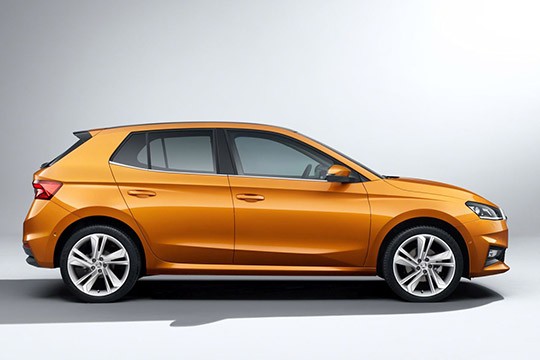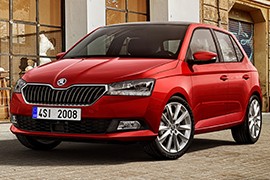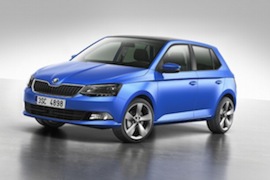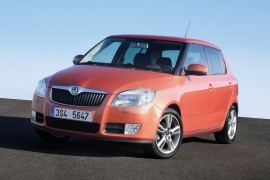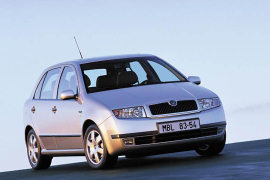SKODA Fabia Models/Series Timeline, Specifications & Photos
First production year: 2000
Engines: Gasoline, Diesel
Body style: Hatchback
Skoda introduced the fourth generation of its small-segment contender, Fabia, in 2021, and its features outrun many compact and mid-size vehicles.
When Volkswagen bought the Czech carmaker, Skoda, its intention was to make it a budget company, which relied on its sales figures rather than in profit per unit. It helped it with technology and many other improvements, but in the end, it was about the Czech workers' stubbornness to build the car properly and make them one of the most reliable in the Volkswagen Group. The Fabia came on the market in 1999, and it was more or less a Volkswagen Polo with different bodywork. In 2021, the Fabia received the MQB-A0 platform used by Audi A1, Volkswagen Polo, and SEAT Ibiza, to name just a few.
The exterior was still dominated by sharp angles and straight lines, resembling the Czech Cubism design concept. Its wide grille with vertical slats and chromed surrounding matched the look of its bigger brothers Scala, Octavia, and Superb. Its front bumper sported a wide grille at the bottom that hosted the side-mounted fog lights. From its sides, the design team made some sculptured areas on the lower side of the doors to channel the air and prevent turbulence near the bodywork. Its 0.28 aerodynamic coefficient confirmed that the engineers' efforts were not in vain.
Inside, Skoda offered one of the roomiest interiors in the segment to that date. The carmaker provided an option for a 10.25" digital instrument cluster and a 9.2" infotainment system, depending on the trim level. Its wheelbase allowed enough room for up to five passengers and a 380 liter (13.4 cu-ft) of trunk space. An intelligent option was the umbrella incorporated into the front driver's door.
Under the hood, Skoda installed a five-engine choice ranged between 65 hp and 150 hp.
The small-class vehicle from the Czech car-maker was the Fabia. In 2015 it already reached its third generation and, in 2018, it received a facelift.
The European small-class segment was important and the Volkswagen group struggled to get the biggest part of it. In order to do that, it developed a platform on which most of the brand inside the group built a vehicle. The Audi A1, the SEAT Ibiza, the Skoda Fabia, or the Volkswagen Polo were built on the same PQ26 platform. But each brand had its design language.
Skoda chose the cubist trend of design, which was the avant-garde art movement in Western Europe, at the beginning of the 20th Century, and there were some Czech artists in that as well. That's why Skoda chose its design language. The angular headlights and the sharp edges along the bodywork were a clear sign of that. A full-LED headlights feature was added to the options list.
Inside, the cubist exterior was replaced by a minimalist trend, especially on the base trim levels. But the options list was long and depending on the trim level the car could have been fitted with an infotainment unit and a 6.5” display on the center stack.
Under the hood, there was only one engine available but offered with or without a turbocharger. The standard transmission was a 5-speed manual for the versions under 100 hp and a 6-speed manual for the 110 hp version. A 7-speed DSG (dual-clutch) automatic transmission was offered for the latter.
The first generation of the Fabia went on sale in 2000 and was awarded the car of the year.
Reaching the 3rd generation released in 2014, the two generations had one thing in common and that was the car of the year award for the 2015 model as well.
The little spacious car was among the tallest in its class, thus offering great headroom for both front and rear passengers. The passengers in the rear seats had a good amount of legroom, however, the 3rd seat was a better fit for a child, due to the central tunnel.
The roomy cabin was equipped with comfortable seats that were adjustable, as well as a telescopic steering wheel contributing to ideal driving position desired by the users.
The Fabia offered great visibility, with its big windows and the thin pillars. The material used throughout the cabin were of a decent quality and the interior was a basic one. The only thing that draw attention was the flashy color touchscreen with a 5-inch display for the lower trim levels and a 6.5-inch one for the upper trims.
The Fabia also offered a good size and shape for the trunk and its practicality was increased with the available storage nets, the hooks and the little shelves. The load area could be extended by folding the rear seats, however, the rear seats did not completely fold down.
The starting price of the Fabia was highly competitive among the others in its class.
Skoda introduced the second generation of the Fabia in 2007, following the successful recipe from its predecessor, which attracted over 1.7-million customers worldwide.
In March 2007, the Czech carmaker unveiled the second generation of its supermini vehicle and said that it would exceed everyone's expectations, and somehow it did. Not only that it was slightly larger than its predecessor, but it was also available in four trim levels. Also, it was built on a new platform, this time developed by Volkswagen, its parent company, from scratch, and shared with Volkswagen Polo and Seat Ibiza.
Even though it still sported some angular shapes, the second generation of the Fabia showed more rounded lines, starting with the swept-back headlights and the grille. On the lower part of the bumper, in the apron, the carmaker placed a second grille flanked by two side scoops for the foglights, offered as an option or standard depending on the trim level. From its sides, the most obvious part of the greenhouse was the C-pillar, which was unusually wide for a car in this class but gave the vehicle a unique presence on the market.
Inside, the base trim level sported a budget-oriented fabric upholstery, while the upper trim levels featured velour and higher quality plastic materials. Also, the car received new sound systems with phone connectivity. Inside the instrument cluster, the carmaker placed the speedometer and tachometer, flanking a center TFT display. Unlike other carmakers, it offered a water temperature gauge as standard. In the back, there was limited room for three passengers on the split-folding bench. The Fabia offered a generously sized, 300-liter (10.6 cu. ft.) trunk.
Under the hood, the Fabia featured a wide choice of engines, either gasoline or turbo-diesel. For selected versions, the carmaker added automatic transmission.
After Volkswagen bought the Czech brand Skoda in the early '90s, it made a plan for the East-European brand, and that included a small-sized lineup, which was the Fabia.
Built from the ground up, the new model was a complete departure from the previous Felicia, which was more of an evolution based on an older Skoda platform. But Volkswagen created the Fabia following the Czech brand heritage, and that helped a lot. Thus, the first generation of this nameplate was an outstanding success. Moreover, it produced the vehicle in three body shapes: hatchback with five doors, sedan, and station wagon.
The cubist design was a Czech trend, and Volkswagen instructed the design department to pen the car following those ideas. Thus, Fabia featured angular shapes, including on the headlights and the grille. With its arched roofline, the rest of the car was modern and dictated by the new design trends in the automotive industry. From its profile, the small-sized hatchback featured a raked-forward rear window, followed by a vertical drop for the rest of the tailgate.
Inside, the car featured the same curved dashboard as the Fabia hatchback. The only rectangular elements on board were the air vents. A simple-to-read and understand instrument cluster featured distinct dials for the speedometer and tachometer and top-mounted gauges for the fuel level and coolant temperature. At the front, the bucket seats were simple, with six manual adjustments. The carmaker installed a split-folding bench in the back that expanded the otherwise small trunk.
Under the hood, Skoda installed a choice of six gasoline and five diesel engines. All of them were paired to a 5-speed gearbox.
